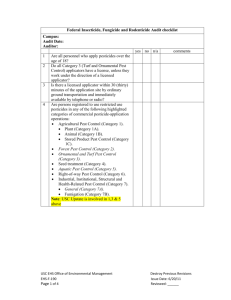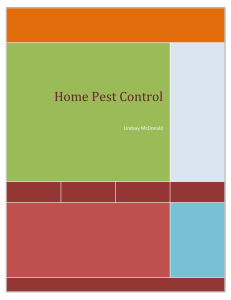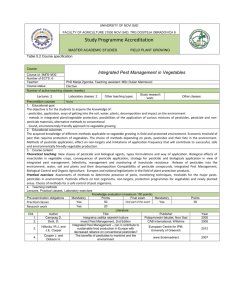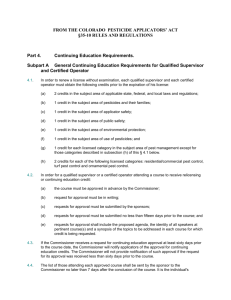Federal Insecticide, Fungicide and Rodenticide Audit checklist yes
advertisement
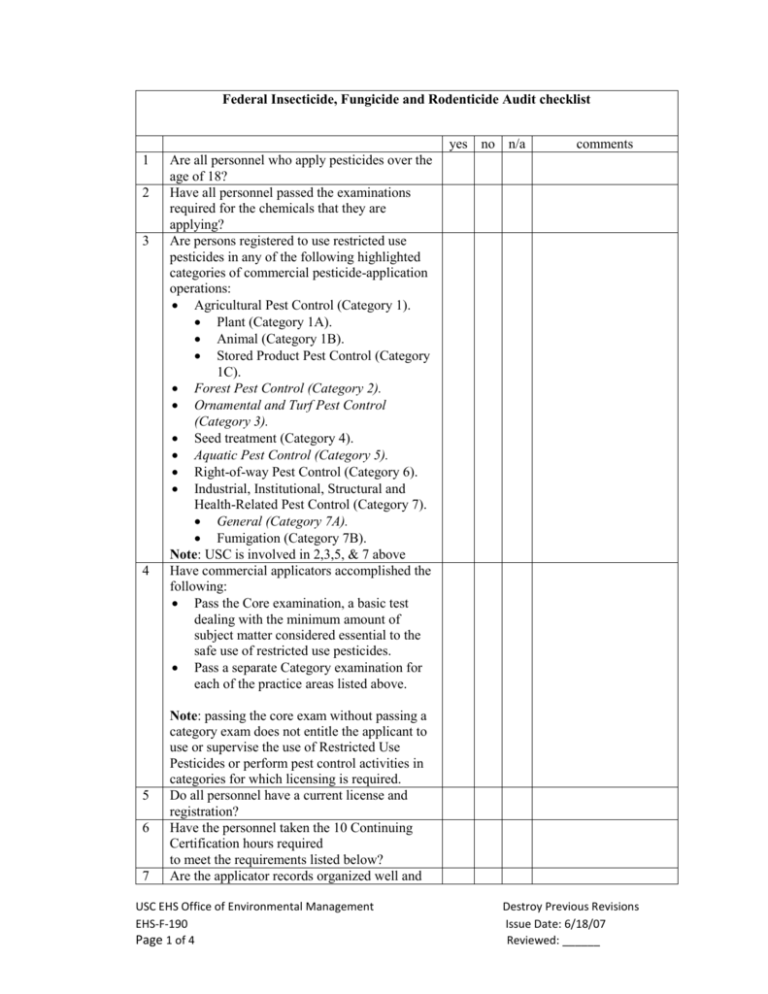
Federal Insecticide, Fungicide and Rodenticide Audit checklist yes no n/a 1 2 3 4 5 6 7 comments Are all personnel who apply pesticides over the age of 18? Have all personnel passed the examinations required for the chemicals that they are applying? Are persons registered to use restricted use pesticides in any of the following highlighted categories of commercial pesticide-application operations: Agricultural Pest Control (Category 1). Plant (Category 1A). Animal (Category 1B). Stored Product Pest Control (Category 1C). Forest Pest Control (Category 2). Ornamental and Turf Pest Control (Category 3). Seed treatment (Category 4). Aquatic Pest Control (Category 5). Right-of-way Pest Control (Category 6). Industrial, Institutional, Structural and Health-Related Pest Control (Category 7). General (Category 7A). Fumigation (Category 7B). Note: USC is involved in 2,3,5, & 7 above Have commercial applicators accomplished the following: Pass the Core examination, a basic test dealing with the minimum amount of subject matter considered essential to the safe use of restricted use pesticides. Pass a separate Category examination for each of the practice areas listed above. Note: passing the core exam without passing a category exam does not entitle the applicant to use or supervise the use of Restricted Use Pesticides or perform pest control activities in categories for which licensing is required. Do all personnel have a current license and registration? Have the personnel taken the 10 Continuing Certification hours required to meet the requirements listed below? Are the applicator records organized well and USC EHS Office of Environmental Management EHS-F-190 Page 1 of 4 Destroy Previous Revisions Issue Date: 6/18/07 Reviewed: ______ 8 available for review? Do applicator records list: the quantity of each pesticide used, received, or purchased? the common chemical name of the active ingredient(s) (not the product name)? the pest or purpose for which the pesticide was applied? the date and place of application? Note: It is not necessary to list the pests involved for general household insect control or for general insect control measures in commercial and industrial establishments. In these cases the record may indicate merely “household pests” or “general insect control.” 9 10 11 12 13 Are the records for pre-construction termitecontrol treatments (“pretreats”), including the installation of bait systems and baits containing active ingredients, records of termiticide application must be maintained for a period of five (5) years? Are the records for post-construction termitecontrol treatments, including the installation of bait systems and baits containing active ingredients, records of termiticide application must be maintained for a period of two (2) years from the date of application? Is there a licensed applicator within 30 (thirty) minutes of the application site by ordinary ground transportation and immediately available by telephone or radio? Does the applicator of all fumigants have an a valid Commercial Applicators License in Category 7B, Category 1C, or other appropriate category as determined by the Department, and is physically present on site and supervising the application at all times when pesticide is being applied. Does the applicator of all pesticides classified as “restricted use” by the EPA or the Department, have an a valid Applicators License in the Category and is within 30 (thirty) miles by ordinary ground transportation of the application site and immediately accessible by telephone or radio? 14 Does the applicator of all pesticides which has USC EHS Office of Environmental Management EHS-F-190 Page 2 of 4 Destroy Previous Revisions Issue Date: 6/18/07 Reviewed: ______ the signal word “danger” or “warning” will require the licensee supervising the application to be within 60 (sixty) miles by ordinary ground transportation of the application site and immediately accessible by telephone or radio? 15 Does the applicator of all pesticides which has the signal word “Caution” will require the licensee supervising the application to be within 100 (one-hundred) miles by ordinary ground transportation of the application site and immediately available by telephone or radio? Handling 1 Are all pesticides stored in quantity stored in securely locked well ventilated rooms, well away from all food or feed items? 2 Are Pesticides separated during storage, preferably in bins, depending upon the type of pesticide? Note: each type of pesticide, i.e., herbicides, insecticides, fungicides, et cetera, must be stored separately from each other? 3 Are the Herbicides not stored in a bin on top of, or located above, any other type of pesticide, to preclude accidental contamination of other pesticides by leakage or spillage? 4 Are there any leaking containers? 5 Are any leaking containers stored in an “overpack” container or similar device that is sufficient to contain the leak? 6 Has any residue been cleaned up by an appropriate decontamination method? 7 Has the location where any pesticide material has been spilled been immediately decontaminated by a method appropriate to the material spilled? Transportation. 1 Do the vehicles used to transport pesticides to and from the application site, or used in the actual application of pesticides, have an identification symbol, furnished by the Department, on both the right and left sides of the vehicle? 2 Is the symbol maintained clean and recognizable from a minimum distance of one hundred feet? Disposal 1 Are unwanted pesticides and pesticide containers disposed of in accordance with the regulations promulgated by the South Carolina USC EHS Office of Environmental Management EHS-F-190 Page 3 of 4 Destroy Previous Revisions Issue Date: 6/18/07 Reviewed: ______ Department of Health and Environmental Control? USC EHS Office of Environmental Management EHS-F-190 Page 4 of 4 Destroy Previous Revisions Issue Date: 6/18/07 Reviewed: ______
